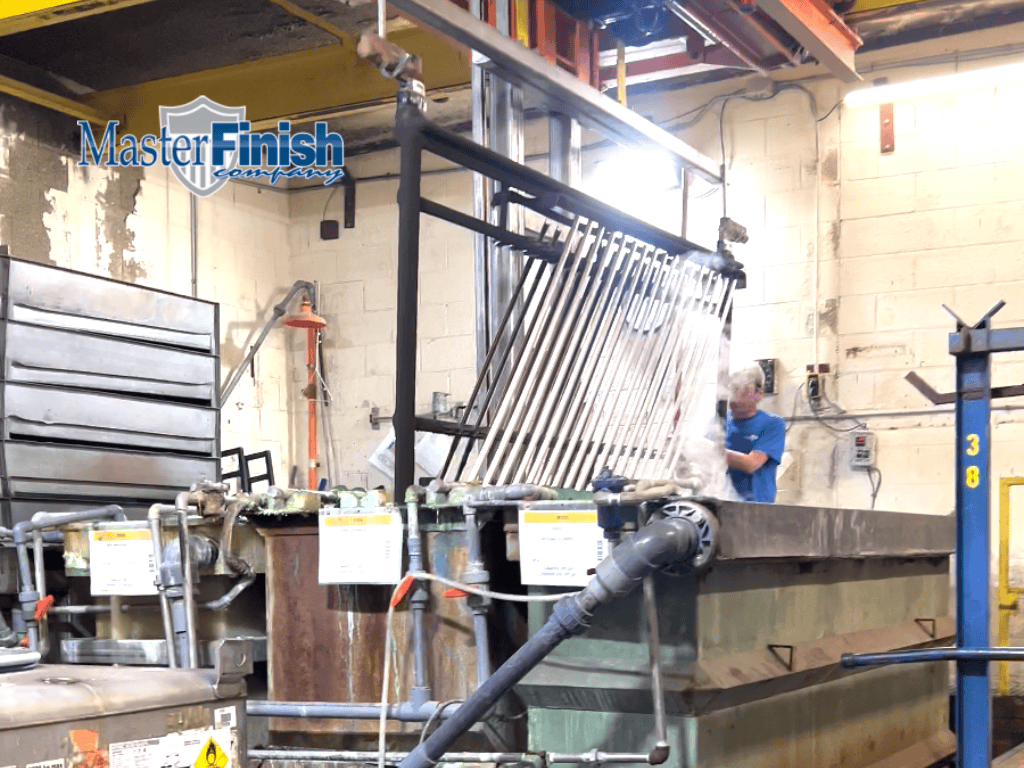Master Finish offers passivation services using Nitric acid. This service uses the chemistry that we have in place for cleaning and stripping the plating racks we use for our chrome plating lines.
Passivation is a chemical process used to improve the corrosion resistance of stainless steel and other metal alloys by removing free iron and other surface contaminants. The most common methods for passivating stainless steel involve using either nitric acid or citric acid. Here’s a detailed comparison of nitric acid passivation and citric acid passivation, along with the benefits of using nitric acid-based passivation:
Nitric Acid Passivation Process:
1. Cleaning: The stainless steel surface is thoroughly cleaned to remove grease, oil, and other contaminants.
2. Passivation: The cleaned stainless steel is immersed in a nitric acid solution (typically
20-50% concentration) at a temperature between 120-160°F (50-70°C) for 20-30
minutes.
3. Rinsing: The metal is then thoroughly rinsed with deionized water to remove any
remaining acid.
Benefits of Nitric Acid-Based Passivation:
1. Effective Removal of Free Iron: Nitric acid is highly effective at removing free iron and other surface contaminants, leading to a more passive and corrosion-resistant surface.
2. Formation of a Stable Passive Layer: The process helps form a thin, stable oxide layer on the surface of the stainless steel, which enhances its corrosion resistance.
3. Versatility: Nitric acid passivation is suitable for a wide range of stainless steel grades and is effective across various industrial applications.
4. Compliance with Standards: Nitric acid passivation is widely recognized and meets many industry standards, including ASTM A967 and AMS 2700.
5. Consistent Results: The process yields consistent and reliable results, making it a preferred choice in industries where high corrosion resistance is critical, such as aerospace, medical devices, and food processing.
Drawbacks:
Environmental Concerns: Nitric acid is hazardous and can generate harmful fumes and waste, requiring proper handling and disposal.
Worker Safety: Handling nitric acid requires stringent safety measures to protect workers from exposure to toxic substances.
Both of these concerns are handled with engineering controls that surpass the
requirements and keep our team members and the local community clean and
safe.
Citric Acid Passivation Process:
1. Cleaning: Similar to nitric acid passivation, the stainless steel surface is cleaned to remove contaminants.
2. Passivation: The cleaned metal is immersed in a citric acid solution (typically 4-10% concentration) at a temperature between 70-140°F (20-60°C) for 30-60 minutes.
3. Rinsing: The metal is thoroughly rinsed with deionized water to remove any remaining acid.
Benefits of Citric Acid-Based Passivation:
1. Environmentally Friendly: Citric acid is biodegradable and less harmful to the environment compared to nitric acid.
2. Worker Safety: It is safer to handle, with lower toxicity and fewer hazardous fumes, reducing risks to workers.
3. Effective Cleaning: Citric acid effectively chelates (binds) iron and other contaminants, cleaning the surface without leaving residues.
Drawbacks:
Potential for Less Effective Passivation: While citric acid can effectively clean and
passivate stainless steel, it may not be as robust in certain applications compared to
nitric acid, especially in highly corrosive environments.
Specific Standards Compliance: Not all industry standards recognize citric acid
passivation to the same extent as nitric acid, which can limit its acceptance in certain industries.
While both nitric acid and citric acid passivation have their advantages and disadvantages, the
choice between them often depends on the specific requirements of the application,
environmental considerations, and industry standards. Nitric acid passivation is known for its
effectiveness, versatility, and consistent results, making it a widely accepted method for
achieving high corrosion resistance in stainless steel.

